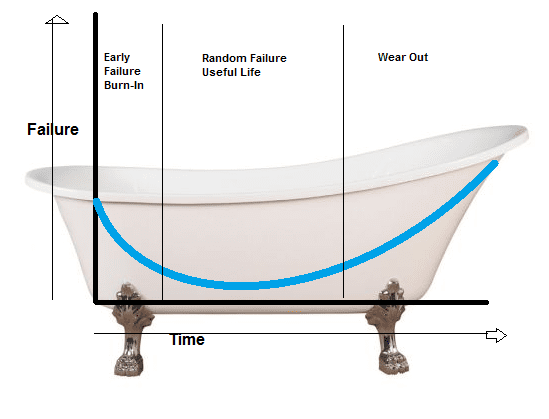Talking about the Reliability of Outdoor LCD Panels
Reliability of Outdoor LCD Panels is a question often asked. Mean Time Between Failures (MTBF) and Mean Time To Failure (MTTF) are performance indicators. They are often used as points of reference for decision making when it comes to the purchase of electronics. We are often asked for the MTBF and MTTF figures for our MetroSpec High Bright LCD Displays that we manufacture.
Firstly, let’s define what these acronyms are:
- MTBF = Mean Time Between Failures: it is a measure of how reliable a product is and usually given in the units of hours. The higher the MTBF, the more reliable the product is
- MTTF = Mean Time To Failure: Unrepairable product. Average time expected until the piece of equipment fails and needs to be replaced.
- MTTR = Mean Time To Repair: Another acronym, referring to the time taken to complete a repair after failure.
Product Reliability
Product Reliability is defined as the ability of a product to perform the requested function under the stated conditions over a period of time. Failure over time can be illustrated using the Bathtub Curve Graph.
The model illustrates in early failure, where the failure rate decreases quickly over time. During the “useful” life period, the product is at its most reliable, with a relatively constant failure rate and “wearout” is when the models are old and fail at an increasing rate. The “useful period” refers to the system life of the product and is the best time frame for making reliability predictions.
Prediction Methods for Reliability of Outdoor LCD Panels
There are various methods for estimating the reliability of electronic equipment. However, the most recognised approach is the Standard Reliability Prediction Method, which uses the MIL-HDBK-217 Hand book. This standard was first published in 1956 in the United States by the Rome Air Development Centre. It is continuously updated and still relied upon today.
It lists two methods: parts count and parts stress and estimates the reliability of diodes, transistors, capacitors, switches, connectors and many other components at various stages of their life. In order for there to be consistency in the results, components are tested in the same environmental conditions – indoors at 25⁰C. Parts Stress is the preferred method. It is proven that more accurate results on system reliability are achieved. Failure rates calculated from MIL-HDBK-217, only apply to the “Useful” Life period of a product. Therefore, reliability of a repairable product can be calculated using MTBF and non-repairable product can be calculated using MTTF.
Product Reliability and MTBF
Electronic products are made up of various electronic components. You would expect that even during the “Useful” life of a product these components could fail. Therefore, the MTBF of a product can be calculated as:
MTBF = 1/(sum of all part failures)
If the MTBF is known, the probability a product will operate for a time period without failure can be calculated as:
P(t) = e (-t/MTBF)
For example: A LCD Panel with a MTBF of 100,000 Hours and expected operating time of 7 years (365 x 24 x 7 = 61,320 Hours) = e(-61320/100000)=0.3868 = Approximately 38.68% of LCD Panels out in the field will still be operating after 7 years.
MTBF cannot be used for predicting a specific time for a product to fail. But it can determine how many products are required to be kept as spares.
MTTF by LCD Panel Manufacturers
LCD Panel manufacturers do not state the MTBF Calculation in their documentation. However, they do state the MTTF for the panel in their specifications. They state the lifetime (MTTF) at minimum being 50,000 Hours with a note “The lifetime (MTTF) is defined as the time which luminance of the LED is 50% compared to its original value [Operating Condition: Continuous Operating at Ta = 25+/-2⁰C]”. This statement can raise various questions and arguments.
MTTF figures stated in Panel manufacturer’s specifications are not considered to be true representation of the definition of MTTF. This is because the product has not stopped operating nor does it need to be repaired. Their description of MTTF relates to the half life of LED Backlights.
LED’s dim slowly over time. Half Life is the average hours the backlight can operate before its brightness is at 50% of what it was originally when it was first turned on. For example if half-life is rated at 50,000 Hours, then the brightness of the LED Backlights with be half as bright at 50,000 Hours. Then if it operates for another 50,000 hours the backlights will be only 25% as bright from when it was first turned on.
So how long will my LCD Panel last?
There is no definitive answer for the above question. The calculated MTTF Figures from the Panel Manufacturer of 50,000 hours is done so in a controlled indoor environment at 25⁰C. However, in real life LCD Panels are subjected to many variables. Each installation is different. We have customers operating our MetroSpec Outdoor LCD Displays 24/7 and others running them only during office hours. Some of our products are subjected to full outdoor conditions where the temperatures can be sub zero and in the summer up over 50⁰C. Others are used underground at Railway Stations in reasonably consistent environments.
However, through years of Research & Development with this product range, Metromatics have implemented bespoke features into our MetroSpec LCD Design. Such as fan control, heating and cooling systems. Plus auto dimming, remote monitoring and internal control systems to enable these products to operate in harsh conditions. In regards to MetroSpec Product Reliability, the results speak for themselves with over 3,000 installations in Australia and Overseas and with units, still operating and delivering for their intended purpose 10+ years on.
To learn more about our the reliability of our outdoor LCD panels, contact us.

